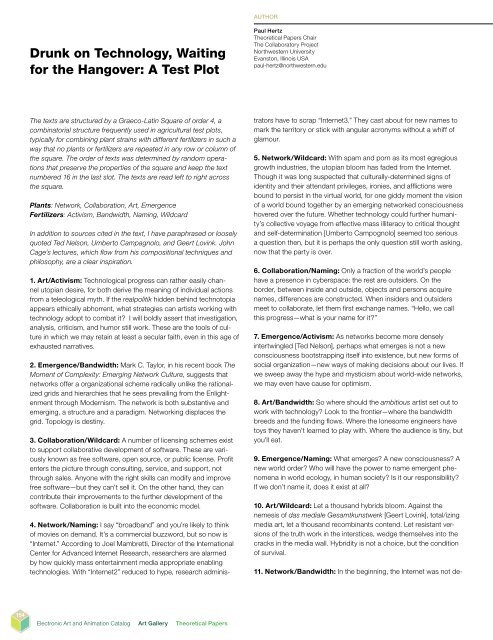Intersections - Nguyen Dang Binh
Intersections - Nguyen Dang Binh
Intersections - Nguyen Dang Binh
You also want an ePaper? Increase the reach of your titles
YUMPU automatically turns print PDFs into web optimized ePapers that Google loves.
5<br />
Drunk on Technology, Waiting<br />
for the Hangover: A Test Plot<br />
The texts are structured by a Graeco-Latin Square of order 4, a<br />
combinatorial structure frequently used in agricultural test plots,<br />
typically for combining plant strains with different fertilizers in such a<br />
way that no plants or fertilizers are repeated in any row or column of<br />
the square. The order of texts was determined by random operations<br />
that preserve the properties of the square and keep the text<br />
numbered 16 in the last slot. The texts are read left to right across<br />
the square.<br />
Plants: Network, Collaboration, Art, Emergence<br />
Fertilizers: Activism, Bandwidth, Naming, Wildcard<br />
In addition to sources cited in the text, I have paraphrased or loosely<br />
quoted Ted Nelson, Umberto Campagnolo, and Geert Lovink. John<br />
Cage’s lectures, which flow from his compositional techniques and<br />
philosophy, are a clear inspiration.<br />
. Art/Activism: Technological progress can rather easily channel<br />
utopian desire, for both derive the meaning of individual actions<br />
from a teleological myth. If the realpolitik hidden behind technotopia<br />
appears ethically abhorrent, what strategies can artists working with<br />
technology adopt to combat it? I will boldly assert that investigation,<br />
analysis, criticism, and humor still work. These are the tools of culture<br />
in which we may retain at least a secular faith, even in this age of<br />
exhausted narratives.<br />
. Emergence/Bandwidth: Mark C. Taylor, in his recent book The<br />
Moment of Complexity: Emerging Network Culture, suggests that<br />
networks offer a organizational scheme radically unlike the rationalized<br />
grids and hierarchies that he sees prevailing from the Enlightenment<br />
through Modernism. The network is both substantive and<br />
emerging, a structure and a paradigm. Networking displaces the<br />
grid. Topology is destiny.<br />
. Collaboration/Wildcard: A number of licensing schemes exist<br />
to support collaborative development of software. These are variously<br />
known as free software, open source, or public license. Profit<br />
enters the picture through consulting, service, and support, not<br />
through sales. Anyone with the right skills can modify and improve<br />
free software—but they can’t sell it. On the other hand, they can<br />
contribute their improvements to the further development of the<br />
software. Collaboration is built into the economic model.<br />
. Network/Naming: I say “broadband” and you’re likely to think<br />
of movies on demand. It’s a commercial buzzword, but so now is<br />
“Internet.” According to Joel Mambretti, Director of the International<br />
Center for Advanced Internet Research, researchers are alarmed<br />
by how quickly mass entertainment media appropriate enabling<br />
technologies. With “Internet2” reduced to hype, research adminis-<br />
Electronic Art and Animation Catalog Art Gallery Theoretical Papers<br />
AUTHOR<br />
Paul Hertz<br />
Theoretical Papers Chair<br />
The Collaboratory Project<br />
Northwestern University<br />
Evanston, Illinois USA<br />
paul-hertz@northwestern.edu<br />
trators have to scrap “Internet3.” They cast about for new names to<br />
mark the territory or stick with angular acronyms without a whiff of<br />
glamour.<br />
5. Network/Wildcard: With spam and porn as its most egregious<br />
growth industries, the utopian bloom has faded from the Internet.<br />
Though it was long suspected that culturally-determined signs of<br />
identity and their attendant privileges, ironies, and afflictions were<br />
bound to persist in the virtual world, for one giddy moment the vision<br />
of a world bound together by an emerging networked consciousness<br />
hovered over the future. Whether technology could further humanity’s<br />
collective voyage from effective mass illiteracy to critical thought<br />
and self-determination [Umberto Campognolo] seemed too serious<br />
a question then, but it is perhaps the only question still worth asking,<br />
now that the party is over.<br />
. Collaboration/Naming: Only a fraction of the world’s people<br />
have a presence in cyberspace: the rest are outsiders. On the<br />
border, between inside and outside, objects and persons acquire<br />
names, differences are constructed. When insiders and outsiders<br />
meet to collaborate, let them first exchange names. “Hello, we call<br />
this progress—what is your name for it?”<br />
. Emergence/Activism: As networks become more densely<br />
intertwingled [Ted Nelson], perhaps what emerges is not a new<br />
consciousness bootstrapping itself into existence, but new forms of<br />
social organization—new ways of making decisions about our lives. If<br />
we sweep away the hype and mysticism about world-wide networks,<br />
we may even have cause for optimism.<br />
. Art/Bandwidth: So where should the ambitious artist set out to<br />
work with technology? look to the frontier—where the bandwidth<br />
breeds and the funding flows. Where the lonesome engineers have<br />
toys they haven’t learned to play with. Where the audience is tiny, but<br />
you’ll eat.<br />
9. Emergence/Naming: What emerges? A new consciousness? A<br />
new world order? Who will have the power to name emergent phenomena<br />
in world ecology, in human society? Is it our responsibility?<br />
If we don’t name it, does it exist at all?<br />
0. Art/Wildcard: let a thousand hybrids bloom. Against the<br />
nemesis of das mediale Gesamtkunstwerk [Geert lovink], total/izing<br />
media art, let a thousand recombinants contend. let resistant versions<br />
of the truth work in the interstices, wedge themselves into the<br />
cracks in the media wall. Hybridity is not a choice, but the condition<br />
of survival.<br />
. Network/Bandwidth: In the beginning, the Internet was not de-

















